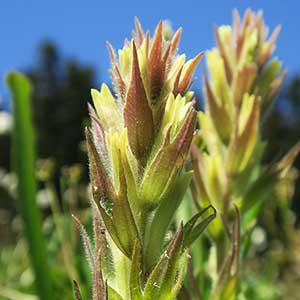Castilleja cryptantha
Castilleja parviflora
Mt. Rainier or obscure paintbrush, obscure Indian paintbrush, obscure paintbrush
magenta paintbrush, mountain Indian paintbrush, mountain or rosy or small-flower paintbrush, small-flower paintbrush
few to several, erect or ascending, unbranched, hairs spreading, long, soft, eglandular, mixed with short stipitate-glandular ones.
several or many, erect or ascending, unbranched except for short, leafy axillary shoots, glabrate proximally, hairy distally, hairs sparse, spreading, ± matted, long, soft, minute-glandular.
green, often with brown or purple veins, narrowly to broadly lanceolate, 1.5–4 cm, not fleshy, margins plane, ± involute, 0–3-lobed, apex acute to acuminate;
lobes spreading-ascending, narrowly lanceolate, apex acute to ± obtuse.
green or gray-green to purple-tinged or deep purple, often blackening on drying, narrowly to broadly lanceolate or elliptic, rarely linear, 1.5–5 cm, not fleshy, margins plane, sometimes ± wavy, flat, (0–)3–9-lobed, apex acute to acuminate or obtuse;
lobes spreading or ascending, linear, sometimes lanceolate, much narrower than terminal lobe, evenly spaced, short, apex acute.
(2.5–)3–6 × 1–2 cm; green to dull brown or dull reddish purple throughout, or proximally green to dull brown or dull reddish purple, distally yellow on apices, broadly lanceolate to ovate, (0–)3-lobed;
lobes ascending, narrowly lanceolate, long or short, arising near mid length, apex acute or acuminate.
2–16 × 1–3.5 cm;
bracts proximally greenish, dull, deep purple, or reddish purple, distally pink, pink-purple, magenta, deep rose, crimson, cream, or white, sometimes red, pale orange, or red-orange, lanceolate to broadly elliptic or ovate, 3–7-lobed;
lobes spreading to ascending, linear, lanceolate, or lanceolate-acuminate, short to medium length, arising at or near mid length, apex obtuse to acute, central lobes sometimes rounded.
straight, 14–16 mm;
tube 11–14 mm;
whole corolla included within calyx;
beak adaxially pale yellow, 1–2 mm;
abaxial lip deep green, slightly inflated, 4–5 mm, 67% as long as beak;
teeth ascending, pale, 1.5–2 mm.
straight or slightly curved, 12–30 mm;
tube 8–19 mm;
beak exserted or subequal to calyx, adaxially green-yellowish or red, 5.5–11 mm;
abaxial lip green, brown, or yellow, sometimes purple, reduced, slightly or not inflated and pouched, 1–3 mm, 20–45% as long as beak;
teeth erect, green, white, yellow, pink, or red, 0.5–2 mm.
proximally green or pale with green veins, lobes yellow, sometimes becoming deep red with age, 12–15 mm;
abaxial and adaxial clefts 3–7 mm, 25–50% of calyx length, deeper than laterals, lateral 1–3(–4) mm, 8–20% of calyx length;
lobes triangular, adaxial segments longer than abaxials, apex acute or obtuse.
colored as bracts, 12–28 mm;
abaxial and adaxial clefts 6–15 mm, 40–70% of calyx length, deeper than laterals, lateral 1–8 mm, 10–35% of calyx length;
lobes narrowly to broadly triangular, sometimes distally expanded and flaring, petaloid, apex obtuse or acute, sometimes rounded.
= 24.
= 24, 48.
Castilleja cryptantha
Castilleja parviflora
Castilleja cryptantha is endemic to the vicinity of Mt. Rainier in the Cascade Range, with most populations found within Mt. Rainier National Park. Unlike most species of Castilleja, it is apparently self-pollinating (W. J. Duffield 1972); the small flowers are entirely enclosed within the yellowish calyces, which tend to grow deep reddish as they age. The purplish brown bracts are also unusual in the genus.
(Discussion copyrighted by Flora of North America; reprinted with permission.)
Varieties 4 (4 in the flora).
Castilleja parviflora is a complex, geographically widespread, and often misunderstood species ranging from southeastern Alaska through much of British Columbia, southwestern Yukon, and the Rocky Mountains of extreme western Alberta and southward in the Cascade Range to central Oregon.
(Discussion copyrighted by Flora of North America; reprinted with permission.)
1. Corollas (18–)20–30 mm; calyces 20–28 mm; leaves (0–)3(–5)-lobed; Oregon, Washington. | var. oreopola |
1. Corollas 12–20(–25) mm; calyces 12–20(–28) mm; leaves (0–)3–9-lobed; Washington to Alaska, Alberta, and Yukon. | → 2 |
2. Bracts distally white to cream, sometimes suffused with pink to purple; herbs 0.6–2.7 dm; n Cascade Range, Washington and s British Columbia. | var. albida |
2. Bracts distally pink-purple, magenta, deep rose, or crimson, rarely white; herbs 1.2–5 dm; Olympic Mountains, Washington, w Canada, se Alaska. | → 3 |
3. Leaves (3–)5–9-lobed; corolla beaks 5.5–7 mm; Alberta, British Columbia, Yukon, Alaska. | var. parviflora |
3. Leaves (0–)3(–5)-lobed; corolla beaks (5.5–)7–9(–11) mm; s Vancouver Island, British Columbia, Olympic Mountains, Washington. | var. olympica |
- Local floras:
BC,
CA,
OR,
WA
- Local Web sites:
CalFlora,
CalPhotos,
Flora NW,
PNW Herbaria,
Turner Photog.
WildflowerSearch
iNaturalist (observations)
USDA Plants Database
- LBJ Wildflower Center
- SEINet
- Plants of the World Online
- Encyclopedia of Life
- Wikipedia
- Google Image Search


